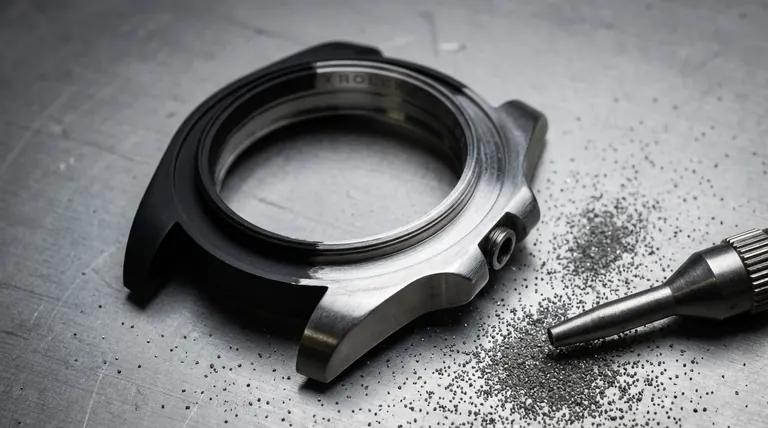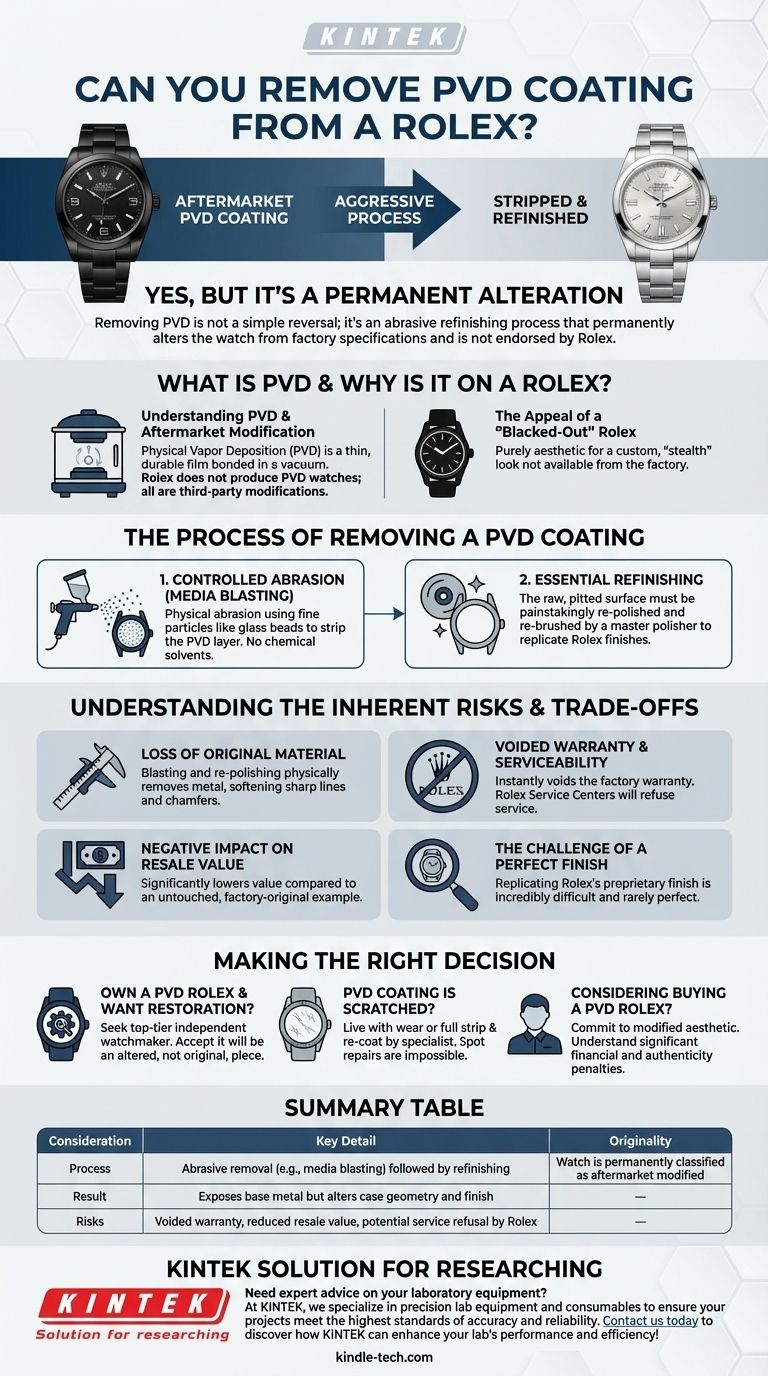Yes, it is technically possible to remove a PVD coating from a Rolex, but this is a highly specialized and aggressive process. It involves physically abrading the coating off the watch case, which strips it down to the bare stainless steel or gold. This procedure is not a simple reversal; it permanently alters the watch from its factory specifications and is not a service offered or endorsed by Rolex.
The core issue is that removing a PVD coating is not a restoration, but a form of abrasive refinishing. While it can expose the original metal, the process inevitably removes a microscopic layer of the watch case itself, subtly altering its original geometry and finish.

What is PVD and Why is it on a Rolex?
Understanding PVD and Aftermarket Modification
Physical Vapor Deposition (PVD) is a process where a thin, durable film is bonded to a material's surface in a vacuum. It is known for its hardness and resistance to wear.
Critically, Rolex does not produce watches with PVD coatings. Any Rolex with such a finish has been modified by a third-party company. This is a crucial distinction, as it immediately classifies the watch as "aftermarket modified."
The Appeal of a "Blacked-Out" Rolex
The motivation behind PVD coating a Rolex is purely aesthetic. Owners seek a custom, "stealth," or all-black look that is not available from the factory. While visually striking, this personalization comes with significant consequences for the watch's originality and serviceability.
The Process of Removing a PVD Coating
The Method: Controlled Abrasion
There is no chemical solvent that can simply dissolve a PVD coating without damaging the underlying steel. Removal is a physical process of abrasion, most commonly achieved through media blasting.
A skilled technician uses very fine abrasive particles (like glass beads or aluminum oxide) to carefully and evenly strip the PVD layer from the case and bracelet.
The Essential Second Step: Refinishing
After blasting, the watch surface is left with a raw, matte, and slightly pitted texture. It does not resemble a factory Rolex finish.
The watch must then be painstakingly re-polished and re-brushed by a master polisher to replicate Rolex's signature combination of finishes. This is an artisanal skill, and the quality of the final result depends entirely on the technician's expertise.
Understanding the Inherent Risks and Trade-offs
Loss of Original Case Material
This is the most significant and unavoidable consequence. The process of blasting and then re-polishing the case physically removes metal. This can soften the sharp, precise lines and chamfers that define a Rolex case, which is a detail highly valued by collectors.
Voiding the Rolex Warranty and Serviceability
Any aftermarket modification, including both applying and removing a PVD coating, instantly voids the Rolex factory warranty.
Furthermore, a Rolex Service Center will refuse to service a modified watch. They may require you to replace the entire case and other modified parts with factory-original ones at a very high cost before they will perform a movement service.
Negative Impact on Resale Value
Originality is the single most important factor in a Rolex's long-term value. A watch that has been PVD coated and then stripped will almost always be worth significantly less than an untouched, factory-original example, even if the refinishing job is excellent.
The Challenge of a Perfect Finish
Even the best watch refinishers in the world find it incredibly difficult to perfectly replicate Rolex's proprietary finish. The luster of the polish or the grain of the brushed steel may be subtly different, which will be apparent to a discerning eye.
Making the Right Decision for Your Watch
Before proceeding, it is vital to weigh the aesthetic goal against the permanent impact on your watch's authenticity and value.
- If you own a PVD Rolex and want to restore its original look: Seek out a top-tier independent watchmaker renowned for case restoration, but accept that the watch will forever be an altered piece, not a factory-original one.
- If your PVD coating is scratched or damaged: Your only options are to live with the wear or commit to a full strip and re-coat by a PVD specialist, as spot repairs are effectively impossible.
- If you are considering buying a PVD Rolex: Do so only if you are committed to the modified aesthetic for your own enjoyment and understand it carries a significant financial and authenticity penalty compared to an original model.
Ultimately, understanding that PVD removal is a permanent alteration, not a simple reset, is the key to making an informed decision about your timepiece.
Summary Table:
| Consideration | Key Detail |
|---|---|
| Process | Abrasive removal (e.g., media blasting) followed by refinishing |
| Result | Exposes base metal but alters case geometry and finish |
| Risks | Voided warranty, reduced resale value, potential service refusal by Rolex |
| Originality | Watch is permanently classified as aftermarket modified |
Need expert advice on your laboratory equipment? At KINTEK, we specialize in precision lab equipment and consumables to ensure your projects meet the highest standards of accuracy and reliability. Whether you're working with delicate materials or require durable tools, our solutions are designed to support your laboratory's needs. Contact us today to discover how KINTEK can enhance your lab's performance and efficiency!
Visual Guide

Related Products
- Custom CVD Diamond Coating for Lab Applications
- RF PECVD System Radio Frequency Plasma-Enhanced Chemical Vapor Deposition RF PECVD
- Electron Beam Evaporation Coating Oxygen-Free Copper Crucible and Evaporation Boat
- Laboratory CVD Boron Doped Diamond Materials
- Vacuum Hot Press Furnace Machine for Lamination and Heating
People Also Ask
- Is diamond coating worth it? Maximize Component Life and Performance
- What are the three types of coating? A Guide to Architectural, Industrial, and Special Purpose
- How are tools coated with diamond? Achieve Superior Hardness and Low Friction for Your Tools
- What is diamond coating film? A Thin Layer of Diamond for Extreme Performance
- What is CVD diamond coating? Grow a Super-Hard, High-Performance Diamond Layer












